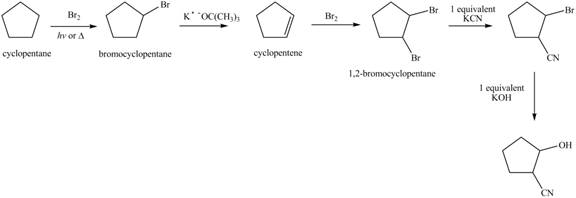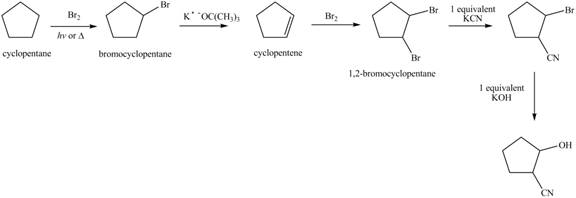
Concept explainers
Devise a synthesis of each compound from cyclopentane and any other required organic or inorganic reagents.
a.  b.
b.  c.
c.  d.
d.  e.
e. 
(a)
Interpretation: The synthesis of given compound from cyclopentane by the use of any other organic or inorganic reagent is to be stated.
Concept introduction: Alkenes undergo bromination reaction at primary, secondary and tertiary carbon atom through free radical mechanism on reaction with
Answer to Problem 15.57P
The synthesis of given compound from cyclopentane by the use of any other organic or inorganic reagent is,

Figure 1
Explanation of Solution
Cyclopentane is used as a starting material and it converts into bromocyclopentane on treatment with

Figure 1
The synthesis of given compound from cyclopentane by the use of any other organic or inorganic reagent is shown in Figure 1.
(b)
Interpretation: The synthesis of given compound from cyclopentane by the use of any other organic or inorganic reagent is to be stated.
Concept introduction: Alkenes undergo bromination reaction at primary, secondary and tertiary carbon atom through free radical mechanism on reaction with
Answer to Problem 15.57P
The synthesis of given compound from cyclopentane by the use of any other organic or inorganic reagent is,

Figure 2
Explanation of Solution
In the first step, cyclopentane undergoes bromination when it is treated with

Figure 2
The synthesis of given compound from cyclopentane by the use of any other organic or inorganic reagent is shown in Figure 2.
(c)
Interpretation: The synthesis of given compound from cyclopentane by the use of any other organic or inorganic reagent is to be stated.
Concept introduction: Alkenes undergo bromination reaction at primary, secondary and tertiary carbon atom through free radical mechanism on reaction with
Answer to Problem 15.57P
The synthesis of given compound from cyclopentane by the use of any other organic or inorganic reagent is,

Figure 3
Explanation of Solution
In the first step, cyclopentane undergoes bromination when it is treated with

Figure 3
The synthesis of given compound from cyclopentane by the use of any other organic or inorganic reagent is shown in Figure 3.
(d)
Interpretation: The synthesis of given compound from cyclopentane by the use of any other organic or inorganic reagent is to be stated.
Concept introduction: Alkenes undergo bromination reaction at primary, secondary and tertiary carbon atom through free radical mechanism on reaction with
Answer to Problem 15.57P
The synthesis of given compound from cyclopentane by the use of any other organic or inorganic reagent is,

Figure 4
Explanation of Solution
In the first step, cyclopentane undergoes bromination when it is treated with

Figure 4
The synthesis of given compound from cyclopentane by the use of any other organic or inorganic reagent is shown in Figure 4.
(e)
Interpretation: The synthesis of given compound from cyclopentane by the use of any other organic or inorganic reagent is to be stated.
Concept introduction: Alkenes undergo bromination reaction at primary, secondary and tertiary carbon atom through free radical mechanism on reaction with
Answer to Problem 15.57P
The synthesis of given compound from cyclopentane by the use of any other organic or inorganic reagent is,

Figure 5
Explanation of Solution
In the first step, cyclopentane undergoes bromination when it is treated with

Figure 5
The synthesis of given compound from cyclopentane by the use of any other organic or inorganic reagent is shown in Figure 5.
Want to see more full solutions like this?
Chapter 15 Solutions
Package: Loose Leaf for Organic Chemistry with Biological Topics with Connect Access Card
- PLEASE ANSWER ALL PARTS!!arrow_forwardd) Determine the formal charge on the nitrogen atom in each of the structures. NH3 NH2 N C бобкат : N N H H Н H2N-OH A B C D E F Garrow_forwardLewis Structure, Hybridization & Molecular Geometry a) Draw the Lewis Structure of the molecules; Label the hybridization of each carbon atom; Predict the approximate molecular geometry around each carbon atom. CH3CHO CH3CN b) Draw the Lewis Structure of Nitromethane; Predict the approximate molecular geometry around the nitrogen atom. CH3NO2 c) Draw the Lewis Structure; Label the hybridization of the boron atom; Predict the approximate molecular geometry. BF3 BF4arrow_forward
- a. The structure of the bicarbonate (hydrogen carbonate) ion, HCO3-, HCO3 " is best described as a hybrid of several contributing resonance forms, two of which are shown here. HO :0: HO + :Ö: Bicarbonate is crucial for the control of body pH (for example, blood pH 7.4). A more self-indulgent use is in baking soda, where it serves as a source of CO2 CO2 gas, which gives bread and pastry their fluffy constituency. (i) Draw at least one additional resonance form. = (ii) Using curved "electron-pushing" arrows, show how these Lewis structures may be interconverted by movement of electron pairs. (iii) Determine which form or forms will be the major contributor(s) to the real structure of bicarbonate, explaining your answer on the basis of the criteria in Section 1-5.arrow_forwardCalibri 11 + BIL NAME: Jaylena M A student is investigating the ctect of volume on pressure during a lab activity. The student uses the following volumes (mL). 12, 13, 14, 16, 17, 18, 19, 20, 21, 22, 23, 24, 26, 28, 30, 33, 34, 35, 38, 40, 42, 44. 46, and 50. As the volume changed they measured the following pressures (atm) 11.0, 10.5, 10.0, 9.2. 8.5, 78, 75, 7.0, 6.8, 6.5, 6.0, 5.9, 5.5, 5.0, 4.8, 4.5, 4.2, 3.9, 3.8, 3.5, 3.3, 3.2, 3.0, 2.9. What is the independent variable? Volume Imla What is the dependent variable? Pressure Jatm Use the data and make a PROPER data table. Volume 1mL) Pressure latm 110arrow_forwardDraw all resonance forms of the molecules. Include curved arrow notation. Label major resonance contributor.arrow_forward
- : Resonance Forms a) Draw all resonance forms of the molecules. Include curved arrow notation. Label major resonance contributor. SO₂ NO3arrow_forward1d. Use Le Chatelier's principle to describe the effect of the following changes on the position of the Haber-Bosch equilibrium: N2(g) + 3H2(g)= 2NH3(9) AH = -92kJ Choose one of the following answers: shift to reactant side, shift to product side or no change and draw the resulting graph. I. Increase the [N2(g)] Effect: H₂ N₂ NH3 II. Decrease the volume of the container. Effect: H₂ N₂2 NH3arrow_forwardf) The unusual molecule [2.2.2] propellane is pictured. 1) Given the bond length and bond angles in the image, what hybridization scheme best describes the carbons marked by the askerisks? 2) What types of orbitals are used in the bond between the two carbons marked by the askerisks? 3) How does this bond compare to an ordinary carbon-carbon bond (which is usually 1.54 Å long)? CH2 1.60Å H₂C * H₂C CH2 C H2C * C Of H₂ 120°arrow_forward
 ChemistryChemistryISBN:9781305957404Author:Steven S. Zumdahl, Susan A. Zumdahl, Donald J. DeCostePublisher:Cengage Learning
ChemistryChemistryISBN:9781305957404Author:Steven S. Zumdahl, Susan A. Zumdahl, Donald J. DeCostePublisher:Cengage Learning ChemistryChemistryISBN:9781259911156Author:Raymond Chang Dr., Jason Overby ProfessorPublisher:McGraw-Hill Education
ChemistryChemistryISBN:9781259911156Author:Raymond Chang Dr., Jason Overby ProfessorPublisher:McGraw-Hill Education Principles of Instrumental AnalysisChemistryISBN:9781305577213Author:Douglas A. Skoog, F. James Holler, Stanley R. CrouchPublisher:Cengage Learning
Principles of Instrumental AnalysisChemistryISBN:9781305577213Author:Douglas A. Skoog, F. James Holler, Stanley R. CrouchPublisher:Cengage Learning Organic ChemistryChemistryISBN:9780078021558Author:Janice Gorzynski Smith Dr.Publisher:McGraw-Hill Education
Organic ChemistryChemistryISBN:9780078021558Author:Janice Gorzynski Smith Dr.Publisher:McGraw-Hill Education Chemistry: Principles and ReactionsChemistryISBN:9781305079373Author:William L. Masterton, Cecile N. HurleyPublisher:Cengage Learning
Chemistry: Principles and ReactionsChemistryISBN:9781305079373Author:William L. Masterton, Cecile N. HurleyPublisher:Cengage Learning Elementary Principles of Chemical Processes, Bind...ChemistryISBN:9781118431221Author:Richard M. Felder, Ronald W. Rousseau, Lisa G. BullardPublisher:WILEY
Elementary Principles of Chemical Processes, Bind...ChemistryISBN:9781118431221Author:Richard M. Felder, Ronald W. Rousseau, Lisa G. BullardPublisher:WILEY





